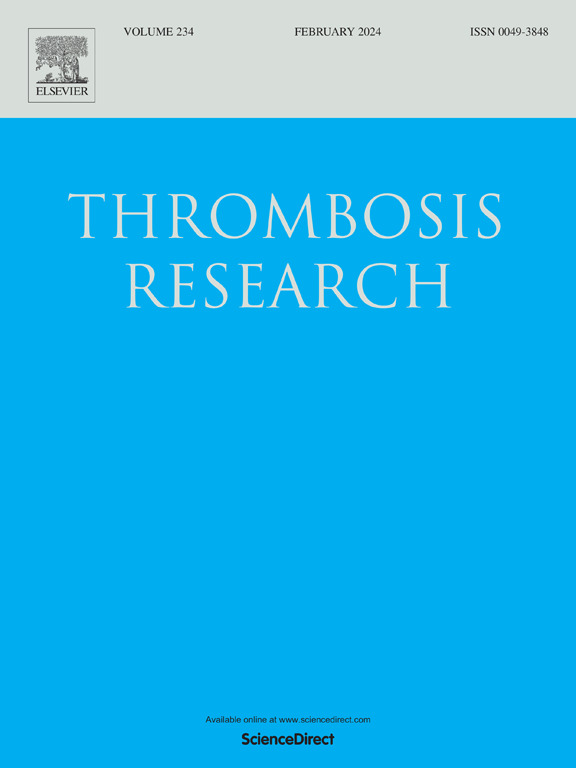Real-time risk stratification in acute pulmonary embolism: the utility of RV/LV diameter ratio
IF 3.7
3区 医学
Q1 HEMATOLOGY
引用次数: 0
Abstract
Background
This study evaluates the prognostic utility of the RV/LV diameter ratio in predicting low cardiac index (CI) in patients with acute intermediate-risk PE.
Methods
We conducted a retrospective analysis of 112 patients with acute PE who underwent catheter-based therapies. The RV/LV diameter ratio was measured from standard axial views on computed tomography pulmonary angiogram (CTPA). Multivariable regression models were used to assess the relationship between the RV/LV diameter ratio and invasive hemodynamic parameters.
Results
A total of 63 patients (56.3 %) had a low CI (≤2.2 L/min/m2). The optimal cut-off for the RV/LV ratio to predict low cardiac index was 1.0 (area under the curve: 0.64). In a multivariable model, the RV/LV ratio (every 0.1 increase) was a significant predictor of low CI (OR: 1.11, 95 % CI 1.01–1.23, p = 0.03). Patients with a high RV/LV ratio (>1.0) had a lower pre-procedure cardiac index (2.0 [IQR 1.7, 2.6] vs 2.7 [IQR 2.4, 3.0] L/min/m2, p < 0.001), higher pre-procedure mPAP (34.0 [IQR 27.0, 41.0] mm Hg vs 28.0 [IQR 20.0, 35.0] mm Hg, p = 0.015), and were more likely to have a low cardiac index (65 % vs 3 %, p = 0.001). Every 0.1 increase in the ratio was associated with a 0.5 mm Hg increase in mPAP (p < 0.001) and a 0.05 L/min/m2 lower cardiac index (p = 0.002). The RV/LV ratio demonstrated moderate sensitivity (64.5 %) and high specificity (84.2 %) for predicting low cardiac index.
Conclusion
The RV/LV diameter ratio offers real-time risk stratification and is a predictor of low cardiac index in patients with acute PE.
急性肺栓塞的实时风险分层:左室/左室直径比的效用
本研究评估了左室/左室直径比在预测急性中危性肺动脉栓塞患者低心脏指数(CI)方面的预后效用。方法回顾性分析112例经导管治疗的急性肺心病患者。通过ct肺血管造影(CTPA)的标准轴向视图测量左室/左室直径比。采用多变量回归模型评估左室/左室直径比与有创血流动力学参数的关系。结果63例(56.3%)患者CI低(≤2.2 L/min/m2)。预测心脏指数低的RV/LV比值的最佳临界值为1.0(曲线下面积:0.64)。在多变量模型中,RV/LV比(每增加0.1)是低CI的显著预测因子(OR: 1.11, 95% CI 1.01-1.23, p = 0.03)。RV/LV比值高(>1.0)的患者术前心脏指数较低(2.0 [IQR 1.7, 2.6] vs 2.7 [IQR 2.4, 3.0] L/min/m2, p <;0.001),较高的术前mPAP (34.0 [IQR 27.0, 41.0] mm Hg vs 28.0 [IQR 20.0, 35.0] mm Hg, p = 0.015),并且更容易出现低心脏指数(65% vs 3%, p = 0.001)。该比值每增加0.1,mPAP升高0.5 mm Hg (p <;0.001),心脏指数降低0.05 L/min/m2 (p = 0.002)。RV/LV比值在预测低心脏指数方面表现出中等敏感性(64.5%)和高特异性(84.2%)。结论右室/左室直径比提供了实时的风险分层,是急性肺动脉栓塞患者低心脏指数的预测指标。
本文章由计算机程序翻译,如有差异,请以英文原文为准。
求助全文
约1分钟内获得全文
求助全文
来源期刊

Thrombosis research
医学-外周血管病
CiteScore
14.60
自引率
4.00%
发文量
364
审稿时长
31 days
期刊介绍:
Thrombosis Research is an international journal dedicated to the swift dissemination of new information on thrombosis, hemostasis, and vascular biology, aimed at advancing both science and clinical care. The journal publishes peer-reviewed original research, reviews, editorials, opinions, and critiques, covering both basic and clinical studies. Priority is given to research that promises novel approaches in the diagnosis, therapy, prognosis, and prevention of thrombotic and hemorrhagic diseases.
 求助内容:
求助内容: 应助结果提醒方式:
应助结果提醒方式:


